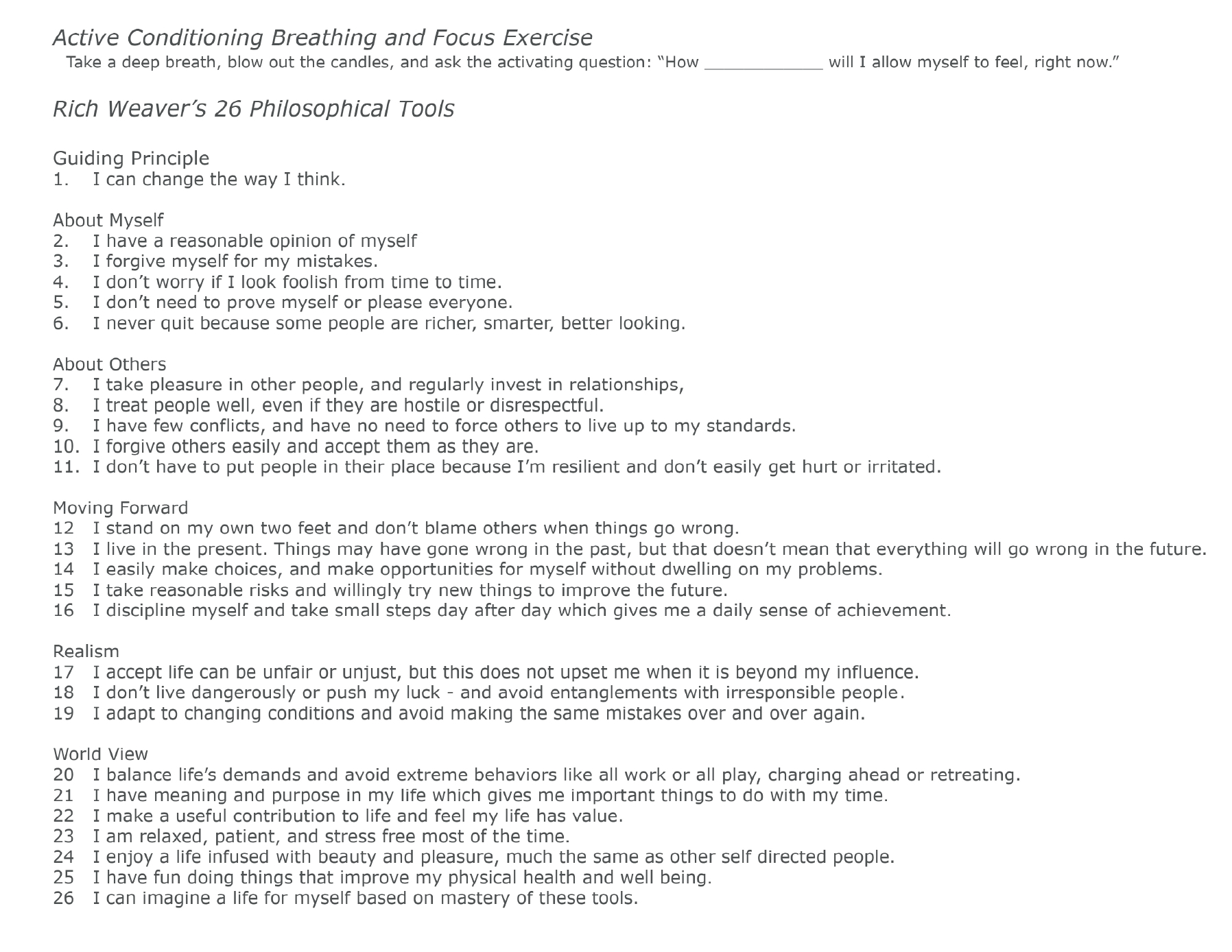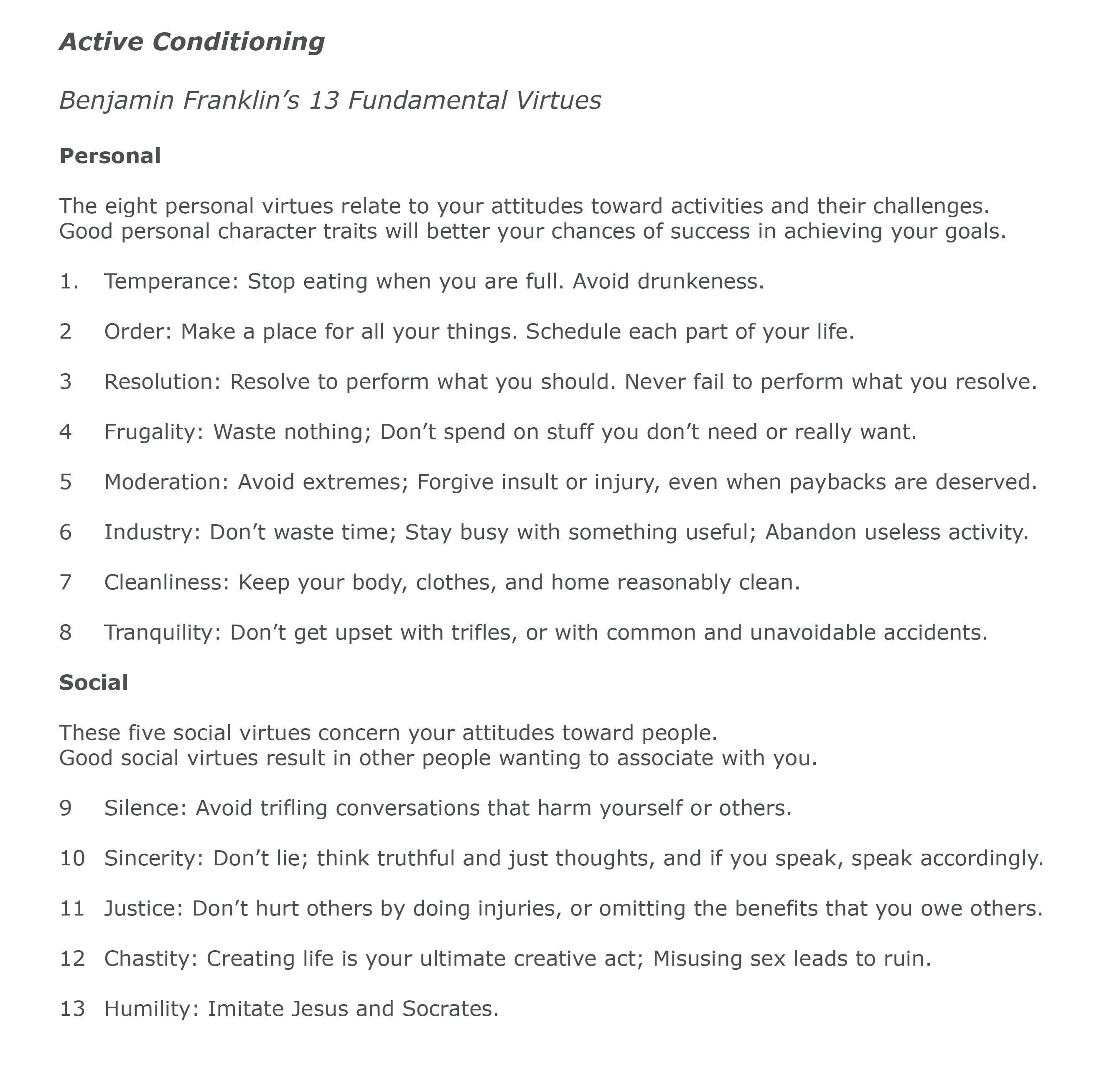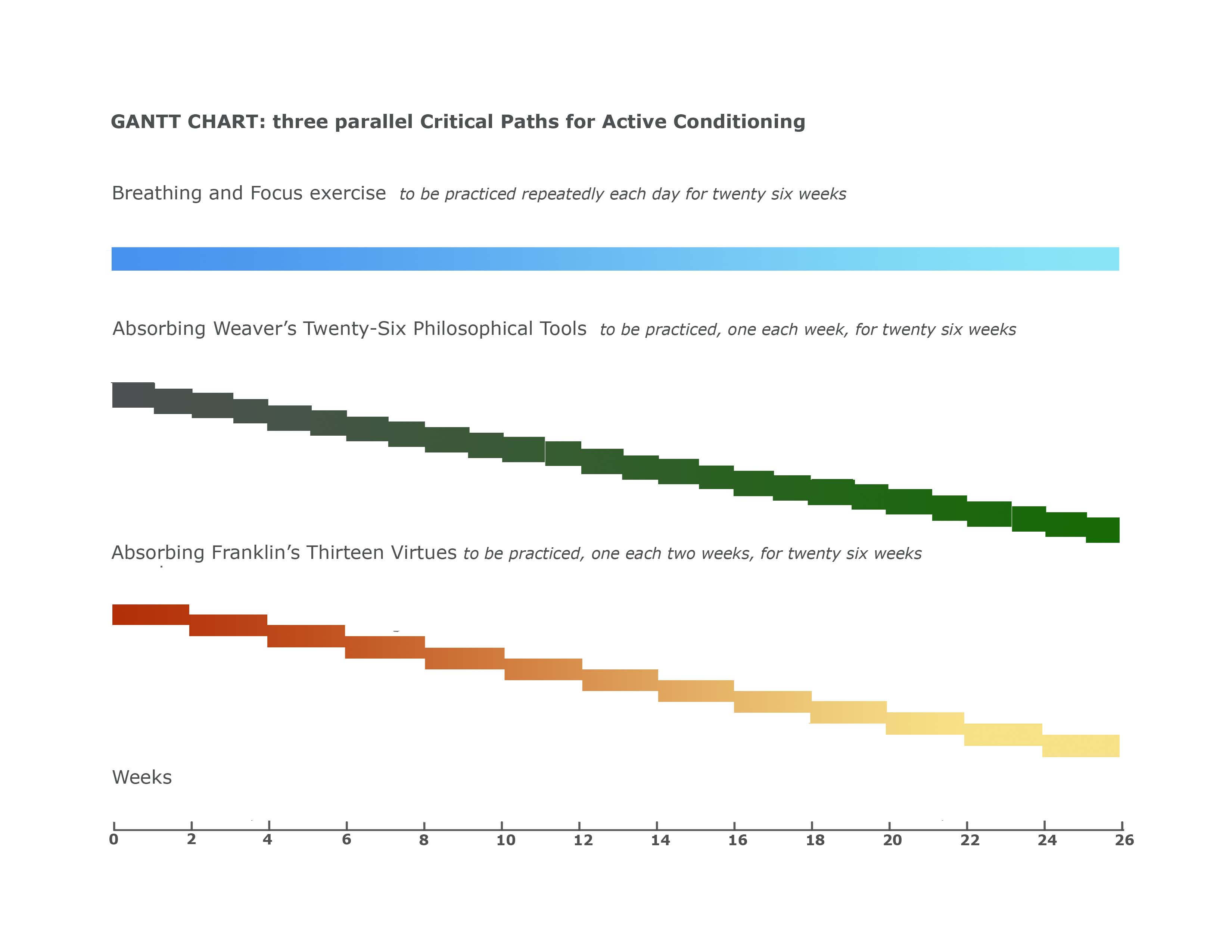We share a message of hope for families that Recovery is a process anyone can learn; anyone can teach, and everyone can experience.
Here is how to do it:
Breathe in Peace
-
Breathe out Stress
-
Relax your neck and shoulders
-
Think about what you want
We can gradually reach a state where stress related symptoms, like a flash temper, or isolation, can become "un-diagnosable!" We Recover as we form new neural pathways that change our thinking, which changes our feelings, and then our behavior changes. When behavior changes, then anything is possible.
When we practice Active Conditioning we are intentionally rerouting electro-chemical impulses as our thoughts seek the path of least resistance in the salt water of the brain. As the electricity in the thought passes through the brain it leaves whispy traces of chemicals. Soon the brain actually starts growing new neural-physical structures call axons and dendrites. These are the parts of the nervous system that actually conduct electricity! Consiencely thinking about the same thing again and again helps form new super nerve highways that grow and grow as more electricity flows through them. We can design and build New paths of least resistance based on what we have decided we want. This is similar to the way cob webs can aggregate into dust bunnys. Thoughts physically alter the brain. We can use this to our advantage as we go about transforming our lives. Change is no longer just possible, it is inevitable. We are able to chose our path.
Recovery puts us on the path to what we call "Abundant Life". Abundance in every section of life: Health, Relationships, Intellectual, Financial, Spiritual. It's all of what we chose to want for ourselves. Brain science proves that people can "Actively Condition" their brains, forming new neural pathways, consciously and on purpose.
This is not some new pseudo science that we really wish was true. This is neurochemistry and neural imaging done at the best universities in the world... including the University of Utah. The new neural pathways can be seen in the brain with a simple microscope. The new axons and dendrites subtilly change the neurochemistry of the brain. When you change the chemistry, the thoughts change. Changed thoughts change feelings. When the feelings change behavior changes. When the behavior changes, everything changes.The scriptures say "As a man thinketh, so is he." Amen.
This way of living is focused on the choices we can make for ourselves based on what we really want. What you want can be the focus of all you do. We do not have to live a life of "coping skills" where everything is based on reacting to what we don't want.
When we are not worried about things that we don't want, those neural pathways atrophy. When a person defines what they want, they soon realize that getting what we want is easy. What is hard is choosing what we want and becomming responsible for achieving what we want. Everyone starts where they are. It's not our location on the path of Recovery that matters. What matters is the direction we are headed. Recovery is not a destination. It is a process. It feels good. It's free.
The opposite of passive is active. The Active Conditioning program we are describing in this book takes about six months. This is not a pill that you just swallow for results. This is exercise for the mind to make it stronger and better able to get us what we really want. There is no alternative to practice. With practice, we get to learn to control our thoughts. It's a process. It's definitely worth it.
First: how do you think about yourself? What are your "Self Statements?" They are the lens through which people experience life. Dr. Rich Weaver of the Salt Lake VA teaches "twenty six philosophical tools" we can use to modify our thought processes. To get the most from Active Conditioning we suggest you contemplate each one of these tools (new self statements) several times a day, for a week. Week one: "I can change the way I think." This is not rocket science. This is much more powerful.

Active Conditioning may seem too simplistic to work. Not so. We become what we think about.
Many, maybe most of us, have been thoroughly conditioned by the random events in our lives. [And by TV] We didn’t choose what happened to us. TV has programmed us. Life just happens, no matter what we want. It's not fair. We are trained from an early age that it is easier to lower our expectations than to experience disappointment when we fail. "And don't try to change me! That's just the way I am!" Doomed.
Like water finding the path of least resistance down a mountain, our thoughts tend to follow paths of least resistance in the brain. Our habitual thinking tends strongly influence how we interpret reality. We somehow remain surprised when the outcomes programmed into us years of building up the same neural pathways somehow yield the same disappointing outcomes. We seem unaware that Recovery allows us to make better and better choices.

I believe that just as Pavlov conditioned dogs to drool; people can choose to systematically condition themselves if they want to. Can you believe that?
We are not saying that you can use self hypnosos to cure a brain injury any more than you can cure an amputation with "positive thinking." Active Conditioning is not self hypnosis. It is a systematic process for changing the brain physiologically. We can choose to Recover, which leads to changes in the neural pathways, which changes the way we think, which changes the way we feel, which changes the way we act.
Change requires desire. I’m saying people CAN consciously, actively, choose the programming or conditioning they want to practice. That’s why we call it “Active Conditioning.” A.C. is a simple, infinitely variable skill, a brief behavior sequence anyone can practice, whenever they want to. Recovery is a process anyone can learn; anyone can teach, and everyone can experience. The more we teach it, the more ingrained it becomes in our own minds. practice, the more automatic the conditioning. It’s not only okay to make choices to try to get what you want, it’s necessary to have a life of joy. Not free of pain, but plenty of happiness… joy.

Here is how to do it:
-
Breathe in Peace
-
Breathe out Stress
-
Relax your neck and shoulders
-
Think about what you want
I want to help people use the knowledge of conditioning to consciously re-set their goals, rather than follow programmed thinking like “This is the way it has always been, and this is the way it will always be.” I think that is simply wrong, and to follow that line of thinking condemns us to the same unsatisfying results forever.
Understanding a "bad tempered Veteran".
The Background Stress level of Veterans with stress brain injury:
“Normal,” un-stressed, un-traumatized folks wake up with a stress level of maybe 2 out of 10. Bad rush hours can take that up a couple of notches, a nasty boss, a few more notches, mean wife – he might get all the way up to 8 on the scale. But a good dinner and a little sex… then down to zero stress and sleep.
Post Traumatic Stress people wake up with a stress level of 7.5. It’s part of the physiological changes that take place in a normal brain responding to abnormal circumstances. This is not a character defect nor are the sleep disturbances and anger issues that go along with it.
Of course, all that doesn't’t seem to matter when the Stressed Out person seems to “Go Ballistic Over Nothing!” when the smallest things go wrong. Doesn’t take much to put a guy over 10 when he is already at 8.75!
The hard thing to deal with is that the person with ptsd feels normal when running at 7 to 8. That’s the way we Always feel. We with ptsd often surprise ourselves with how instantly and automatically we go ballistic. As if we had no control. There is no time between stimulus and response. It’s a survival mechanism that stays with us after combat.
Another problem is that PTS brains are not particularly sensitive to emotions other than anger or fear. People say we can’t be intimate. We feel emotionally numb. The volume is already turned up so loud on stressors that it’s hard to pay attention to feelings and emotions that merely whisper to us. “Nuanced feelings?” Forget that.
In other words; if we are always giving 75% of our energy to dealing with chronic stress from PTSD, we only have 25% of our energy and attention to give to solving problems, building solid relationships, and trying to be happy. It's hard when we only have 25% of our lives left overt to be alive!
If that were the end of the story for those with PTSD, That Would Be Depressing As Hell.
Fortunately, we now know, through the miracle of neuro- magnetic visualization and incredible brain chemistry research what is actually happening in the brain as it happens. What we are learning is that Recovery is possible. We can form new structures in the brain to help us get what we want. Like stroke victims, we are not necessarily "cured" of the injury. The broken part of the brain stays broken. But we can, through practice, teach different parts of the brain to take over the functions of the injured part. Symptoms become un-diagnosable.
Active Conditioning acts like a pillow between stimulus and response as the new neural pathways are formed. We can restructure the brain so we don't have to worry about coping with rage. We can consciously choose to form new neual pathways that create different responses to the stimulus. We are empowered when we decide how we will react to a stressor.
This is not to say anger does not have it’s value or it’s place. Of course it does.
As long as I can remain angry, I can stay focused on you, and not have to take responsibility for me. Sometimes we are not aware that it’s our choices that are blowing us towards dangerous shoals. We think “We’re jinxed anyway. Doomed. Why should I even try to overcome anger? I Like Anger.”
Anger can easily descend into rage. Rage is a fundamental primate survival skill. Remember the apes in the movie “2001”using bones for clubs? Uncapped rage can consume our lives, burning up over things we can not control or even influence. It’s like an addiction. Or we can invest our lives in the realm of what we can influence or, personally, what we can control. Giving into Rage is about the polar opposite of Active Conditioning... It's conditioning all right. But there is no CHOICE in it. Except the choice not to choose.
Another sad observation: in our PTSD world, stress evokes the un-conditioned responses of anger, confusion, avoidance, or depression. These, and other uncontrolled, unpleasant and ill-managed stress reactions, often drive people away from us. The worst of it is that what stressed out Veterans need most of all in a crisis are relationships, where it's okay if we "have our moments of difficulty" maintaing what the rest of the world considers "good manners." When we tear into the people who are closest to us, we can loose the support of a resilient social safety net, sometimes forever.
Only a strong social safety net (Family?) can divert us from the crash and burn that always comes when stress eventually overwhelms our coping skills. Stress always wins over coping because coping is 100 percent reactive. Coping is alway playing catch up. This is a losing strategy...
Recovery allows us to change the course of our lives. We can learn to reprogram our minds so we don't need the coping skills because we have learned how to think differently about stressors that used to tear us up. In other words, coping skills for dealing with stress become irrelevant when the stress has somehow evaporated as a result of us changing our habits of thought. It sounds simple because it is simple.
Recovery is not a game and it's not easy. Recovery is akin to learning a new skill like bicyle riding or playing guitar. It takes desire and it takes practice. Before all else is the belief that change is possible. That belief is what we want to be selling!
What if a person could have a sudden awakening and overnight learn how to take charge of their mental and physical condition? Just imagine: you blink, then realize that you can bring to pass anything you desire, through the infinite powers of your mind. What would you choose if you could choose anything? What would you try if you knew you couldn’t fail?
Belief in Recovery, is an immovable fulcrum of Hope. Recovery is Possible. We have proof! Hope is what we strive to share with all who will listen. With the lever of desire and courage to continue to strive for Recovery even when all seems lost; Anything is Possible
The power of free choice and transformational focused desire is the beginning of Recovery.
_/_/_/_/_/_/_/_/_/_/_/_/_/_/_/_/_/_/_/_/_/_/_/_/